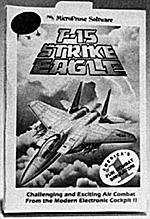
Programmed by Sid Meier
Microprose Software 120
Lakefront Dr., Hunt Valley, MD
21030
Released: November,
1984
Price: $34.95 for 48K
disk
Complexity:
Intermediate
Solitaire
Suitability: High
F-15 Strike Eagle is a real-time computer flight simulation which gives the solitaire player control of an F-15 fighterbomber. The object of the game is to bomb one or more primary targets while avoiding or destroying enemy aircraft and missle batteries. There are seven scenarios with four levels of difficulty ranging from ARCADE (easvy to ACE (almost impossible). The game is available for the ATARI, APPLE II, and COMMODORE 64 computers. This review is based on my experiences with the ATARI version.
This is really an excellent game. It combines the best of strategy and arcade action without putting a premium on reflexes alone. You are always busy making strategic decisions about hight paths, armament, fuel supply; and anticipating various threats. At the same time you must fly the plane to the target and engage in combat. The graphics in the game are excellent.
There is a large amount of information displayed on the screen, but it is well organized and it quickly becomes secondnature to absorb what is happening. The bottom part of the screen is the instrument panel which is divided into three parts. On the left is the Horizontal Position Display which shows where you are located on the strategic map. In the center is the radar screen and threat indicators. On the right is the weapon status display which shows your remaining armament.
The top half of the screen is the view from the cockpit and the Heads Up Display (HUD). The HUD contains heading and speed information, pitch lines, air target designators, and navigational aids. It is also possible to "check your 6" by pressing the space bar to get a view from the back of the cockpit. The screen display scrolls smoothly and is updated constantly
The player communicates with the computer by one or two joysticks and the keyboard. The primary joystick is used to control the pitch and heading of the aircraft. The second joystick is optional and duplicates throttle and weapon commands that can also be entered from the keyboard. The keyboard is used to control many functions, including weaponry, throttle settings, counter-measures, and (gasp) bailing out. Every action that a player takes causes some change to the screen, so it is always possible to recognize what you have done. The coordination between the commands and the action on the screen is smooth and accurate. The letters used for the various commands are logical, and you quickly learn to fly the plane without having to search for keys.
In each mission, there are one or more primary targets that must all be destroyed to complete successfully the mission. These targets are protected by anti-aircraft batteries and enemy aircraft. It is also possible to destroy the enemy missile batteries and airfields. As you fly toward the objectives, you constantly use your radar screen to identify approaching threats.
You use long range missiles, short range missiles, and guns to shoot down enemy aircraft. When enemy missiles are fired, you can either try to outmaneuver them or use Electronic Counter Measures and flares to cause them to miss.
When the target comes into range, you arm your bombs and go in for a low-level attack, trying to place your bomb aiming point on the target without either flying into the ground or getting shot down by enemy missiles. In some of the higher level scenarios, things can get quite frantic. It seems as though the warning buzzers indicating enemy missile launches are almost constantly sounding and enemy aircraft are everywhere. it should be noted that you always see the threats coming in time to decide on a course of action.
This is not an arcade game, where reflexes predominate, but it is a combination of strategy and reflexes. After you have successfully completed your mission, you must fly back to your base without running out of fuel. It is also possible to land, refuel, rearm, and fix damage at the base in order to continue the scenario if you fail to complete it in one try. Landing and taking off are not covered in the game, but it is enough of challenge without them. one nice capability is the pause control which allows you to answer the phone without being shot down.
The seven different scenarios increase in difficulty, with more threats and targets in each. No scenario ever seems to play the same way twice in a row. There are many different strategies that you can choose: you can either try to take out the enemy airfields and missile batteries, go for the primary objectives, or use a combination of both strategies. No matter how you decide to go, you will not be bored!
This game is highly recommended. it makes full use of the computer, is challenging but easy to play, and is worth every penny of iis cost. You actually feel as though you are flying the plane, countering the threats, and accomplishing the mission.
More Reviews
-
Game Review: Time Master: Sea Dogs
Game Review: Bandit Gangs and Caravans
Game Review: Throne of Evil
Game Review: Convoy
Game Review: The Desert Environment
Game Review: Trouble for Havoc
Game Review: F-15 Strike Eagle (Computer Sim)
Game Review: Web and Starship
Game Review: Napoleon in Spain
Game Review: Struggle for the Throne (Star Trek)
Game Review: Forces of Fantasy
Game Review: Talisman
Game Review: Dragonriders of Pern
Game Review: King's Court
Game Review: The Soap Opera Game
Game Review: Judge Dredd
Back to Table of Contents -- Game News #4
To Game News List of Issues
To MagWeb Master Magazine List
© Copyright 2000 by Dana Lombardy.
This article appears in MagWeb (Magazine Web) on the Internet World Wide Web.
Other military history articles and gaming articles are available at http://www.magweb.com